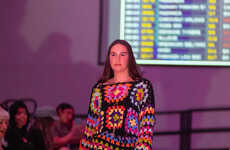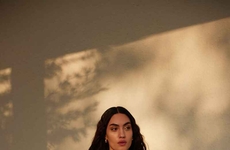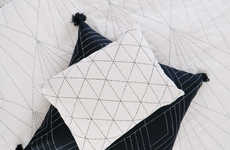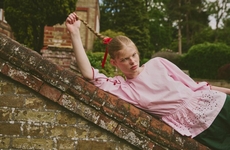
Facilitating Fair Trade Fashion
Jennifer Gosnell — October 10, 2013 — Social Good
References: matatraders
Jonit Bookheim, partner at Mata Traders, has an innovative business mind that is working towards spreading fair trade style around the world. Mata Traders focuses on bringing greater opportunity to the women of India through fair trade. Here, Jonit Bookheim answers some questions for Social Business.
Four Questions with Jonit Bookheim
1. How did the idea for the business model come about?
We are three best friends who met in college, and after we graduated, we started traveling together. We went backpacking in Europe and spent a year working in Australia, during which time we also visited Southeast Asia. We fell in the love with traveling and the feeling you get when you’re out there exploring the world, seeing new things, and meeting new people. We saved up our money and in 2003 we embarked on a round-the-world trip that included 4 months in India. We loved the vibrant colors of India, the textiles and handicrafts, and we met a fantastic woman from Seattle who had been importing from India and Bali. That gave Maureen the idea to import, too, and the next year she went back to India on a buying trip and started Mata Traders.
Maureen first went back to India with a $3000 credit card and sent a bunch of stuff home - everything from leather sandals to vintage tapestries to sets of bangles. She crashed on her cousin’s couch that summer in Martha’s Vineyard and sold her wares at an outdoor market there. Her booth was a success -- she sold through most everything she had bought. Some people asked her if her products were fair trade, and she looked into what that meant. As it happened, the Fair Trade Futures Conference was that fall in Chicago, so Maureen attended. She realized that, of course, she’d have to source fair trade from then on. On our travels, we’d seen widespread poverty and we asked ourselves why that was happening and what we could do. Finding fair trade was the perfect fit and she realized her purchasing power could be used for good. On her next trip she sought out fair trade groups to make clothes and accessories for her, like bags and pillow shams. We still work with those same groups today.
2. How did you decide to join this sector?
Maureen always had a knack for selling things. Even as a kid, she knew how to make things sell. At her lemonade stand, she would up-sell by adding a twizzler straw for $0.50 more. Michelle joined up with Maureen after finishing a grad degree in English Lit in 2007. I don’t think they had any long term plans in mind, but Maureen needed a partner and the timing was right for Michelle. At first they relied on selling at Chicago neighborhood street fests in the summers and holiday fairs in the winter, and they had outside income from a seasonal gig together selling posters on college campuses. Meanwhile, I had been working at an amazing homeless service organization here in Chicago and realized that whatever I did, I wanted to be passionate about it and to work towards the cause of social justice. But I missed being abroad, so I went back to school to get a grad degree in Sustainable Development, thinking that eventually I could work for an international NGO on poverty programs. As it turned out though, Mata Traders was growing and not long after I graduated, I joined as a third partner. We’re so amazed that it’s come far enough now to not only support ourselves but a Chicago staff of ten people!
3. How do you get your inspiration?
Our designs are a little vintage-inspired and a little boho. We try to create flattering silhouettes and fun details like pockets and ruching. We do our trend research to stay current as far as colors and shapes. But we take inspiration from everywhere -- books, magazines, Pinterest, people we see on the street. A lot of our aesthetic comes from the traditional handmade processes used in production. Most of our fabrics are woven, block printed, or screen printed by hand. We also have pieces with intricate embroidery, which are hand stitched by rural women in their own homes. So, overall our look combines traditional craft elements with modern cuts and color palettes. We also get to design our own prints, which is really fun. Our Spring/Summer ‘14 collection incorporated some east Asian elements in the prints, inspired by Korean room screens and Japanese fans and origami.
4. How do you reset yourself to be creative? Do you have any rituals?
Both our design and marketing processes are pretty collaborative. So I think everyone here just works off each other and is comfortable bringing their ideas to the table. We just try to make the work environment supportive and let everyone have a voice. The philosophy is that the more eyes on something the better because there’s always room for improvement.
Four Questions with Jonit Bookheim
1. How did the idea for the business model come about?
We are three best friends who met in college, and after we graduated, we started traveling together. We went backpacking in Europe and spent a year working in Australia, during which time we also visited Southeast Asia. We fell in the love with traveling and the feeling you get when you’re out there exploring the world, seeing new things, and meeting new people. We saved up our money and in 2003 we embarked on a round-the-world trip that included 4 months in India. We loved the vibrant colors of India, the textiles and handicrafts, and we met a fantastic woman from Seattle who had been importing from India and Bali. That gave Maureen the idea to import, too, and the next year she went back to India on a buying trip and started Mata Traders.
Maureen first went back to India with a $3000 credit card and sent a bunch of stuff home - everything from leather sandals to vintage tapestries to sets of bangles. She crashed on her cousin’s couch that summer in Martha’s Vineyard and sold her wares at an outdoor market there. Her booth was a success -- she sold through most everything she had bought. Some people asked her if her products were fair trade, and she looked into what that meant. As it happened, the Fair Trade Futures Conference was that fall in Chicago, so Maureen attended. She realized that, of course, she’d have to source fair trade from then on. On our travels, we’d seen widespread poverty and we asked ourselves why that was happening and what we could do. Finding fair trade was the perfect fit and she realized her purchasing power could be used for good. On her next trip she sought out fair trade groups to make clothes and accessories for her, like bags and pillow shams. We still work with those same groups today.
2. How did you decide to join this sector?
Maureen always had a knack for selling things. Even as a kid, she knew how to make things sell. At her lemonade stand, she would up-sell by adding a twizzler straw for $0.50 more. Michelle joined up with Maureen after finishing a grad degree in English Lit in 2007. I don’t think they had any long term plans in mind, but Maureen needed a partner and the timing was right for Michelle. At first they relied on selling at Chicago neighborhood street fests in the summers and holiday fairs in the winter, and they had outside income from a seasonal gig together selling posters on college campuses. Meanwhile, I had been working at an amazing homeless service organization here in Chicago and realized that whatever I did, I wanted to be passionate about it and to work towards the cause of social justice. But I missed being abroad, so I went back to school to get a grad degree in Sustainable Development, thinking that eventually I could work for an international NGO on poverty programs. As it turned out though, Mata Traders was growing and not long after I graduated, I joined as a third partner. We’re so amazed that it’s come far enough now to not only support ourselves but a Chicago staff of ten people!
3. How do you get your inspiration?
Our designs are a little vintage-inspired and a little boho. We try to create flattering silhouettes and fun details like pockets and ruching. We do our trend research to stay current as far as colors and shapes. But we take inspiration from everywhere -- books, magazines, Pinterest, people we see on the street. A lot of our aesthetic comes from the traditional handmade processes used in production. Most of our fabrics are woven, block printed, or screen printed by hand. We also have pieces with intricate embroidery, which are hand stitched by rural women in their own homes. So, overall our look combines traditional craft elements with modern cuts and color palettes. We also get to design our own prints, which is really fun. Our Spring/Summer ‘14 collection incorporated some east Asian elements in the prints, inspired by Korean room screens and Japanese fans and origami.
4. How do you reset yourself to be creative? Do you have any rituals?
Both our design and marketing processes are pretty collaborative. So I think everyone here just works off each other and is comfortable bringing their ideas to the table. We just try to make the work environment supportive and let everyone have a voice. The philosophy is that the more eyes on something the better because there’s always room for improvement.
Trend Themes
1. Fair Trade Fashion - Disruptive innovation opportunity: Explore new ways to create sustainable, fair trade fashion that empowers marginalized communities.
2. Handmade Craft Elements - Disruptive innovation opportunity: Integrate traditional craft techniques into modern designs to create unique and authentic products.
3. Collaborative Design Process - Disruptive innovation opportunity: Embrace a collaborative work environment that encourages creativity and diverse perspectives.
Industry Implications
1. Fashion - Disruptive innovation opportunity: Revolutionize the fashion industry by prioritizing ethical sourcing, fair trade practices, and sustainable production methods.
2. Textile and Handicraft - Disruptive innovation opportunity: Modernize the textile and handicraft industry by incorporating innovative design techniques and sustainable production methods.
3. Design and Marketing - Disruptive innovation opportunity: Develop collaborative design and marketing processes to tap into diverse perspectives and create innovative products.
4.1
Score
Popularity
Activity
Freshness























